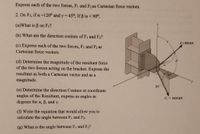Question
Please solve A to D much important to me plz...

Transcribed Image Text:Express each of the two forces, Fi and F2 as Cartesian force vectors.
2. On F2, if a =120° and y = 45°; If ß is < 90°,
(a)What is B on F2?
(b) What are the direction cosines of Fi and F2?
E=8.0 kN
(c) Express each of the two forces, F1 and F2 as
Cartesian force vectors.
(d) Determine the magnitude of the resultant force
of the two forces acting on the bracket. Express the
resultant as both a Cartesian vector and as a
30
magnitude.
30
(e) Determine the direction Cosines or coordinate
angles of the Resultant, express as angles in
degrees for a, B, and y.
F = 10.0 kN
(f) Write the equation that would allow you to
calculate the angle between Fı and F2.
(g) What is the angle between F1 and F2?
Expert Solution
This question has been solved!
Explore an expertly crafted, step-by-step solution for a thorough understanding of key concepts.
This is a popular solution
Trending nowThis is a popular solution!
Step by stepSolved in 5 steps with 1 images

Knowledge Booster
Similar questions
arrow_back_ios
arrow_forward_ios